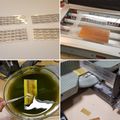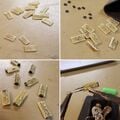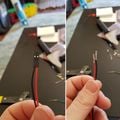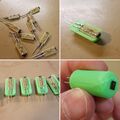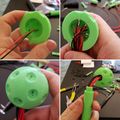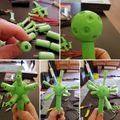Project
This project involved designing and building a modular spherical microphone array with the aid of 3d printing. The result is a set of analog MEMs microphones, connectors and a spherical microphone matrix which can be interconnected and rearranged for various audio applications. The microphones used for this set are AKU143 Akustica MEMs microphones which have a fairly omnidirectional and flat from 50 Hz to 10 kHz. The spherical microphone matrix contains 19 channels distributed as the faces of an Icosahedron, the 20th side is used as the base for the handle of the microphone. The radius of the matrix directly connected to mics is 5 cm but extra 2.5 cm connectors can be added to increase the radius of the array or to create an array with dual radiuses.
This project was developed as a final assignment for the course L3999 at Aalto University in spring 2018.
Background
The growing industry of virtual reality has created a demand for capturing and reproducing sound fields in a manner that is both immersive and engaging. Plane-wave decomposition has proven to be an appropriate theoretical framework to achieve this it can cover all the major stages of audio engineering (recording, producing and reproduction). [1]. This approach requires arrays of sensors to capture a sound field to then decomposed it into another of sets signals through a set of basis functions. A spherical arrangement for these sensors is convenient for there exist robust mathematical concepts, such as Spherical Harmonics [2], to describe a sound field. The determining factors which will determine the quality of spherical array processing are determined by the number of sensors used, the directionality of the sensors, their position around the surface of a sphere as well as their distance from the origin. The microphone designed in this project intends to be a flexible tool to explore sensor arrangements for plane-wave decomposition for it allows adjustability in most of these aforementioned factors.
Materials
The 3D printing STL files can be found here: [3]
OpenSCAD files for the microphone parts can be acquired here:
Negatives for PCBs can be found here: [4]
Spec sheet for the MEMS microphones can be found here: [5]
Components for one Microphone:
1 AKU143 Akustica MEMs microphone [6]
1 180 Ω resistor SMD 0805
1 7.5k Ω resistor SMD 0805
1 2.2μ F capacitor SMD 0805
1 1μ F capacitor SMD 0603
2 male pin connectors
Components for Matrix
38 female pin connectors
Thin isolated electrical wire.
Instructions
1. 3D print at least one Core A, Core B and Handle from the STL files, and as many Mic Heads and Links as required. Mic Heads and Links must be printed in pairs for the STL contains half of the part so electronics might be introduced.
2. Produce PCBs for MEMS microphones, these are double-sided PCBs.
-
DIY PCB manufacturing.
3. Solder components to PCBs. MEMs microphones and male pin connectors are connected to the side of the PCB
-
SMD Soldering.
4. Solder pin connectors to cables for Matrix and Links.
-
Two pin connector cables FTW.
5. Insert and secure cables and pins inside 3D printed parts using some type of glue. I used super glue.
-
Electronics inside microphone.
6. Glue 3D printed parts together. Again, super glue.
-
Putting everything together.
7. Arrange microphone at will
-
.
Future Steps
My next step in this project is to test this microphone in various arrangements and see how the spatial correlation changes. I intend to test the microphone for potential noise due to the parasitic effects of the connectors
